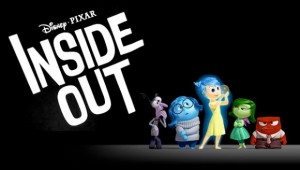Movie Review: Inside Out
 Inside Out, the new Pixar movie about Riley, an eleven-year-old girl whose world is turned upside down when her family moves from Minnesota to San Francisco, is good, but not great. It’s very much a kid’s movie (with knowing asides to parents, as these films always have).
Inside Out, the new Pixar movie about Riley, an eleven-year-old girl whose world is turned upside down when her family moves from Minnesota to San Francisco, is good, but not great. It’s very much a kid’s movie (with knowing asides to parents, as these films always have).
When I first saw the trailer for the film, I guess I had very high expectations. I was elated that children were going to be taught about their interior life–that they even have one! Dramatizing the interior life, externalizing it, is always one of the biggest challenges in film, unlike literature which can write reams about characters’ inner movements. Film can mostly only show.
Film will use narration, flashbacks or other tools to let us know what a character might be thinking or feeling at a deeper level–beyond facial expressions and body language–but Inside Out is taking us right inside–as a cartoon can certainly do!
Factor in that Riley plays hockey? This film, thought I, must have fallen right out of heaven.
Inside Out is highly imaginative with eye-popping color. We spend a good deal of the movie inside Riley’s brain with her five key emotions: Joy (green-female), Sadness (blue, of course-female), Anger (red-male), Disgust (Green-female), and Fear (purple-male). Not having read much about the making of this film, I’m intrigued at the thought process/research that chose/named these as the primary emotions.
Joy is all by herself as Riley’s sole emotion when Riley is a baby, but Sadness follows immediately when Baby Riley begins wailing. (I would actually have put Sadness or Fear first, since birth can be traumatic and babies often cry right at birth.)
Riley’s brain is “Headquarters,” and Joy is in charge at the control panel as she and the gang look through Riley’s eyes at the action in Riley’s life. “Looking through Riley’s eyes” is essentially monitoring a huge screen.
Memories Riley makes are turned into colored bowling-ball-sized “memory balls” that roll around in chutes and pipes in Headquarters and then get stored elsewhere. Each memory ball acts like a crystal ball with an animated GIF playing over and over in a loop. “Core memories” are the most important–happy, formative touchstones from Riley’s childhood (many of them involving hockey). They are gold and must be protected at all costs.
Outside of Headquarters (that looks essentially like the Seattle Space Needle) are islands of Riley’s personality: family, goofball, hockey, friendship, honesty, etc. We are treated to all kinds of hilarious manifestations and personifications of: abstract thought, long term memory, jingles that get stuck in our heads forever, imagination, dreams, nightmares, forgetfulness, the subconscious, you name it.
As far as the message kids might get about emotions? I’m sorry to report that the emotions are completely in charge. It’s unclear where cognition and willpower come in. Riley never takes the reigns of her emotions (OK, she’s only 11)–instead, they control her.
We are made to see the worth of each emotion and the purpose they serve and how well things work when they all work together, but Riley seems like an automaton, simply and only driven by events, memories and feelings. Any kind of thought process (notwithstanding the “train of thought”–the main means of transportation in Riley’s noggin) is really beside the point.
There’s a certain anthropology here, methinks. I know certain schools of thought (ha ha) stress that we are driven by our emotions more than anything else, or emotion associated with positive and negative experiences in our lives. And I suppose when we’re young, or if we live an “unexamined,” non-reflective life, we might continue to be all through our lives. I just would like to have seen more, well, thinking and reasoning. The emotions seem to be scrambling to save the day (literally) all the time.
The plan for Riley’s life seems to be: let’s just keep her happy, day after day, year after year, so she can have a happy life! Without giving too much away, if at a certain point in the film Joy gets annoying (even though she’s fairly moderate and not terribly naive), don’t worry–she’ll be tempered. Sadness serves a very big purpose in our lives. One Mom made a great point about this film: It’s appropriate that we find Joy with Sadness and Sadness with Joy (rather than Joy with Anger, Disgust or Fear).
The best takeaway, perhaps, is simply what can happen when our emotions do get out of control, and how we need a full range of emotions in our lives to balance each other out. The worst thing that could happen to us is to not feel our emotions or let just one of them take over. At Riley’s nadir, it really answers the question we sometimes ask ourselves: “What happens to people? What happens to people to make them so turned off on life?”
Riley’s parents are wonderful: realistic and loving–a great thing to see in a film. And not only that, we get to see inside their brains once in a while, too.
Maybe I’m asking too much of this kid’s film. Maybe the film had to focus on one aspect of the human person (emotions). Maybe the interplay of mind, will and heart (affectivity) is too complex for an child’s animated film.
I’m sure parents and kids are having great conversations about emotions, and I will bet my bottom dollar that at Junior’s next meltdown, Mom and Dad are appealing to Inside Out: “Junior, remember in the movie when….”

